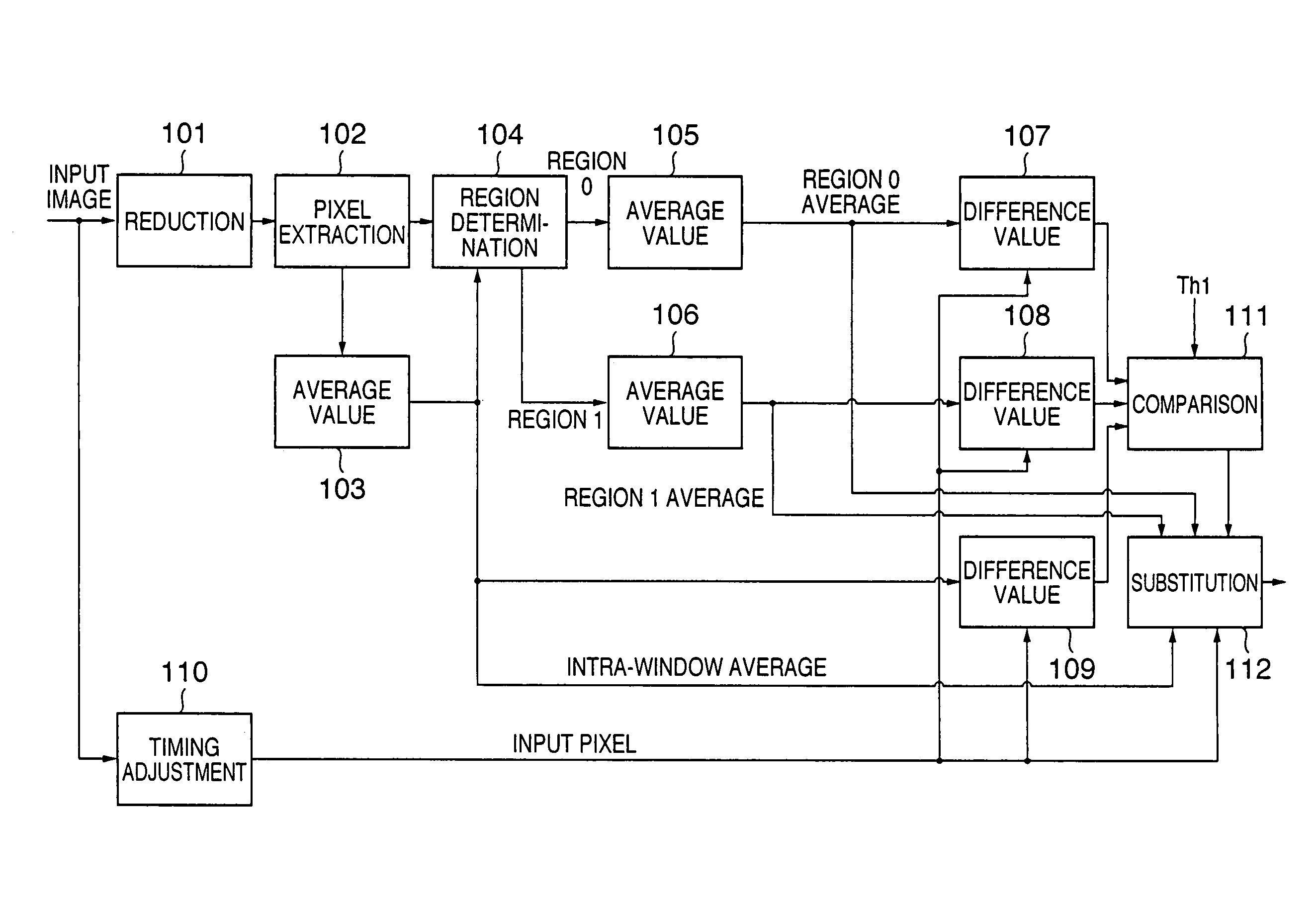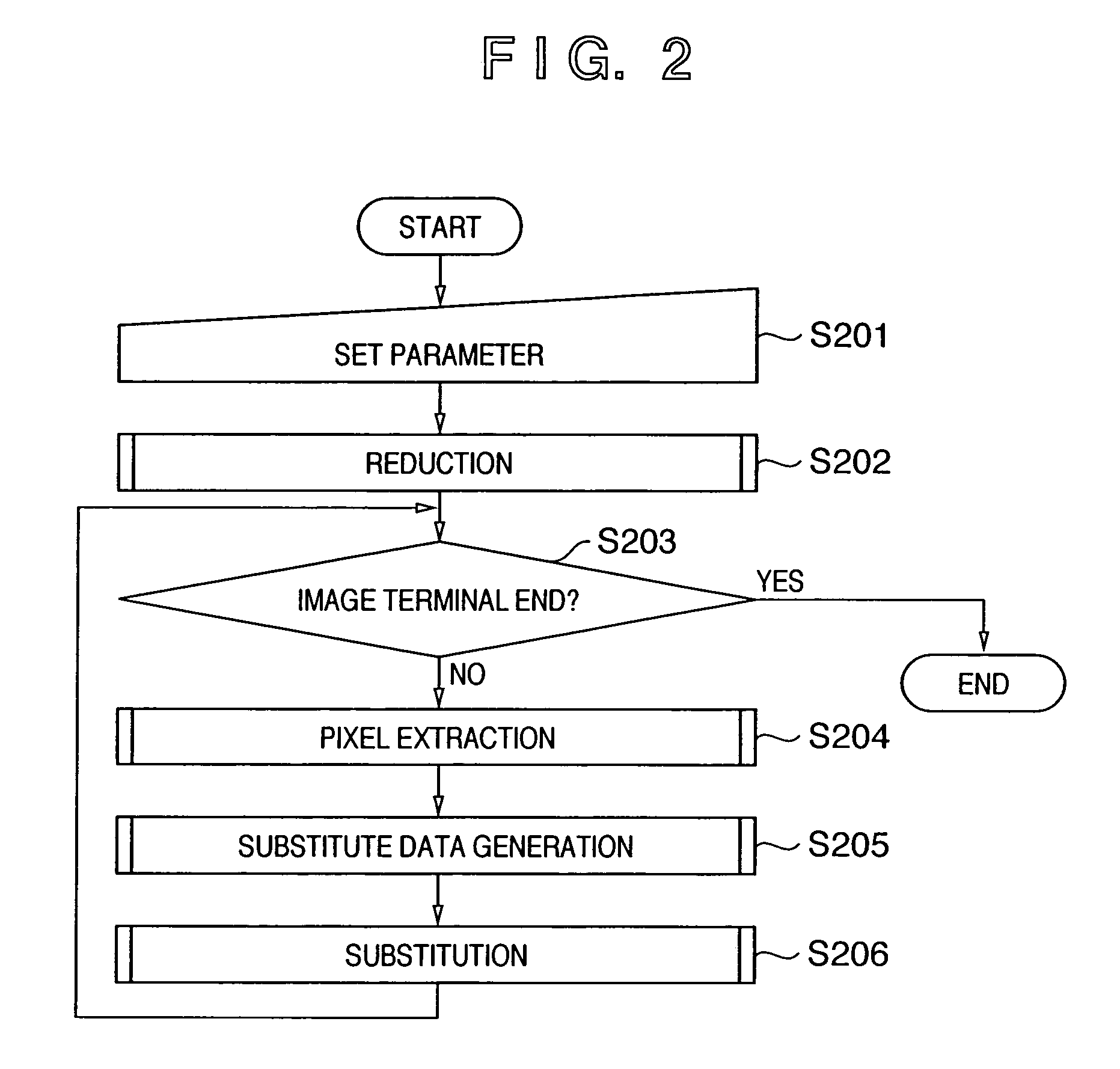Image processing method
- Summary
- Abstract
- Description
- Claims
- Application Information
AI Technical Summary
Benefits of technology
Problems solved by technology
Method used
Image
Examples
first embodiment
[0083]FIG. 1 is a block diagram showing the arrangement of an image processing apparatus according to the first embodiment. Referring to FIG. 1, reference numeral 101 denotes an image reduction unit, which reduces an input image to a predetermined scale (e.g., ¼). Reference numeral 102 denotes a pixel extraction unit, which extracts pixels to an n×m (m and n are integers) rectangular pattern (window) having an input pixel position as the center from the reduced image. Reference numeral 103 denotes an intra-window average value calculation unit, which generates an average value of the extracted pixel values in the window. Reference numeral 104 denotes a region determination unit which compares, e.g., downsize pixel values in the window with the intra-window average value, and determines that pixels whose pixel values are equal to or smaller than the intra-window average value belong to region 0, or determines that other pixels belong to region 1. Reference numeral 105 denotes a regio...
second embodiment
[0100]The second embodiment of the present invention will be described in detail hereinafter with reference to the accompanying drawings.
[0101]In the second-embodiment, in a window in which the difference between the average values of two regions is small, an intra-window average value is determined as substitute data.
[0102]FIG. 5 is a block diagram showing the arrangement of an image processing apparatus according to the second embodiment. Referring to FIG. 5, reference numerals 501 to 506 and 507 denote units which execute the same processes as those of the units 101 to 106 and 110 shown in FIG. 1 in the first embodiment, and a detailed description thereof will be omitted. Reference numeral 508 denotes an average value calculation unit; 509, 513, and 514, comparison units; 510 and 511, selection units; 512, a subtraction unit; 515, a difference value generation unit; and 516, a pixel substitution unit. Only differences from the first embodiment will be explained below.
[0103]The av...
third embodiment
[0111]The third embodiment of the present invention will be described in detail hereinafter with reference to the accompanying drawings.
[0112]In the third embodiment, in the substitute data generation process explained in the second embodiment, the average value of two regions is output as substitute data in accordance with a random number generated by a random number generation unit.
[0113]FIG. 8 is a block diagram showing the arrangement of an image processing apparatus according to the third embodiment. Referring to FIG. 8, reference numerals 801 to 807 and 810 to 812 denote units which execute the same processes as those of the units 501 to 507 and 514 to 516 shown in FIG. 5 in the second embodiment, and a detailed description thereof will be omitted. Reference numeral 808 denotes a random number generation unit; and 809, a selection unit. Only differences from the second embodiment will be explained below.
[0114]The random number generation unit 808 generates a pseudo random numb...
PUM
 Login to View More
Login to View More Abstract
Description
Claims
Application Information
 Login to View More
Login to View More - R&D
- Intellectual Property
- Life Sciences
- Materials
- Tech Scout
- Unparalleled Data Quality
- Higher Quality Content
- 60% Fewer Hallucinations
Browse by: Latest US Patents, China's latest patents, Technical Efficacy Thesaurus, Application Domain, Technology Topic, Popular Technical Reports.
© 2025 PatSnap. All rights reserved.Legal|Privacy policy|Modern Slavery Act Transparency Statement|Sitemap|About US| Contact US: help@patsnap.com



